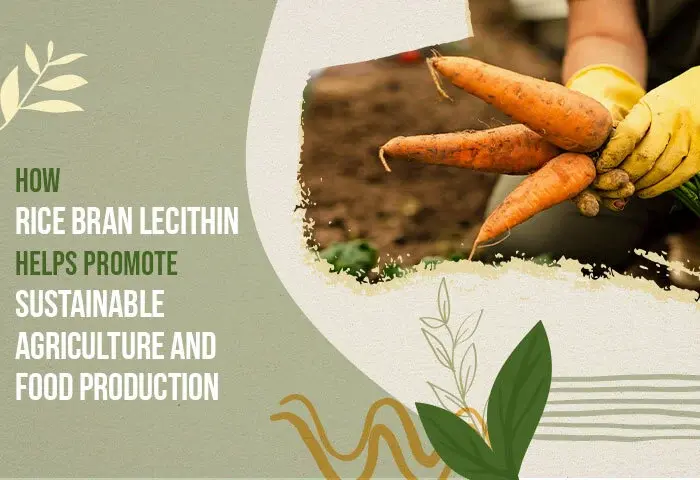Agriculture has long been the backbone of human civilization, providing sustenance, livelihoods, and a deep connection to the land. In our ever-growing world, the importance of agriculture cannot be overstated, but it comes at a cost. Traditional farming practices have often been detrimental to our environment, depleting soil, polluting water, and endangering biodiversity. This has led to a critical need for sustainable agriculture.
Sustainable Agriculture
Sustainable agriculture is not just a buzzword; it’s a necessity for the future. It’s the practice of cultivating food in ways that are not only economically viable but also environmentally friendly and socially responsible.
Rice Bran Lecithin as a Sustainable Agricultural Solution is One fascinating solution that’s making waves in the world of sustainable agriculture is Rice Bran Lecithin. Derived from the humble rice plant, this natural compound possesses a remarkable array of properties that can revolutionize how we farm and produce food.
In this blog post, we will come to know about its composition, role in sustainable agriculture, and application in food production. By the end of this blog, you’ll have a clearer understanding of how this innovative solution contributes to a more sustainable and prosperous future for agriculture and food production.
Understanding Rice Bran Lecithin
Rice Bran Lecithin is emerging as a powerful player in sustainable agriculture and food production. This natural compound, derived from rice bran, has a rich history and a promising future.
Sources of Rice Bran Lecithin
Rice Bran Lecithin is derived from rice bran, the outer layer of rice grains removed during milling. This byproduct of rice milling has often been underutilized or discarded. However, with technological advancements and a growing interest in sustainability, rice bran has found a new purpose.
Rice Bran Lecithin’s source, rice bran, is readily available as a byproduct of rice production, making it an attractive option for sustainable agriculture and food production.
Historical Use in Traditional Agriculture
While Rice Bran Lecithin may seem like a recent discovery, its use in traditional agriculture dates back centuries, particularly in Asia. In traditional farming practices, rice bran was often incorporated into the soil as a natural soil conditioner and fertilizer. Farmers recognized its ability to improve soil structure, enhance water retention, and promote healthier crop growth.
The Role of Rice Bran Lecithin in Sustainable Agriculture
- Reduced Pesticide Dependence: One of the critical aspects of sustainable agriculture is minimizing the use of harmful chemicals. Rice Bran Lecithin has shown promise as a natural pest repellent. Farmers can reduce their reliance on synthetic pesticides by using them in farming practices, which can adversely affect the environment and human health.
- Benefits for Beneficial Insects: Sustainable agriculture involves creating a balanced ecosystem within the farmland. Rice Bran Lecithin’s pest-repelling properties not only protect crops but also encourage the presence of beneficial insects, such as pollinators and predators of harmful pests. This natural balance contributes to a healthier and more biodiverse agricultural environment.
Water Conservation
- Reduced Water Usage: In an era where water scarcity is a growing concern, sustainable farming practices must prioritize water conservation. Rice Bran Lecithin aids in this endeavour by improving soil structure and water retention. Soils enriched with Rice Bran Lecithin can retain moisture more effectively, reducing the need for excessive irrigation.
- Prevention of Water Pollution: Traditional agricultural practices can lead to water pollution through runoff containing synthetic fertilizers and pesticides. By reducing the use of these chemicals and promoting natural alternatives like Rice Bran Lecithin, sustainable agriculture conserves water and safeguards the quality of water sources.
Improving Crop Health and Yield
Pest and Disease Management
- Natural Repellent Properties: Rice Bran Lecithin possesses natural properties that deter many common agricultural pests. When applied to crops or soil, it acts as a natural repellent, reducing the need for chemical pesticides. This is not only better for the environment but also for the long-term soil health and farmworkers’ safety.
- Fungal Disease Prevention: Fungal diseases can devastate crops and reduce yields. Rice Bran Lecithin has shown promise in preventing such diseases by forming a protective barrier on plant surfaces. This barrier inhibits fungal spore attachment and growth, helping to keep crops healthy and productive.
Increased Crop Yield
- Nutrient Absorption Enhancement: One of the key factors in increasing crop yields is ensuring that plants can absorb essential nutrients effectively. Rice Bran Lecithin aids in this process by improving nutrient uptake through the roots. This means crops can access the nutrients they need for healthy growth more efficiently, leading to higher yields.
- Stress Tolerance: Plants are often subjected to various forms of stress, such as drought, extreme temperatures, and nutrient imbalances. Rice Bran Lecithin can help crops become more resilient to these stressors. It improves the plant’s ability to withstand adverse conditions, minimising yield losses even under challenging circumstances.
Sustainable Food Production
Applications in Food Processing
- Stabilizing Food Products: Food manufacturers often face challenges in ensuring that products remain stable on the shelf and during transportation. Rice Bran Lecithin acts as a natural emulsifier, helping to blend ingredients that would otherwise separate, such as oil and water. This property is especially valuable in creating food products like salad dressings, sauces, and margarine, where stability is key.
- Reducing Food Waste: In a world where food waste is a pressing concern, any solution extending product shelf life is invaluable. Rice Bran Lecithin’s emulsifying properties contribute to food preservation by preventing spoilage and separation. This reduces food waste and promotes sustainability by reducing the need for frequent product replacements.
Impact on Food Quality
- Improved Nutritional Value: Sustainable food production isn’t just about quantity but also quality. Rice Bran Lecithin enhances the nutritional profile of food products. It can be used to fortify foods with essential nutrients like vitamins and minerals, making them more nutritious for consumers.
- Clean Labeling: Modern consumers are increasingly concerned about the ingredients in their food. Rice Bran Lecithin’s natural origin makes it an appealing option for clean labelling, meeting the demand for transparency in food production. This aligns with sustainable food production principles by promoting honesty and accountability in the industry.
Challenges and Limitations
Potential Drawbacks of Using Rice Bran Lecithin
- Production Costs: The extraction and purification process of Rice Bran Lecithin can be energy and resource-intensive, which may pose cost challenges for some farmers and food producers. Balancing these costs with the benefits is essential for widespread adoption.
- Variability in Composition: The composition of Rice Bran Lecithin can vary depending on the source and extraction methods. This variability may affect its effectiveness in different applications and require additional quality control measures.
- Limited Awareness and Accessibility: Despite its potential, Rice Bran Lecithin is not yet widely known or accessible in some regions. Raising awareness and improving accessibility to this sustainable solution is crucial for its global adoption.
Addressing Sustainability Challenges
- Improved Extraction Techniques: Research into more efficient and environmentally friendly extraction methods for Rice Bran Lecithin can help reduce the energy and resource costs associated with its production.
- Quality Standards and Certification: Developing industry-wide quality standards and certifications for Rice Bran Lecithin can ensure consistency in composition and quality, making it a more reliable and marketable product.
- Education and Training: Providing farmers and food producers training and resources on using Rice Bran Lecithin can help bridge the knowledge gap and encourage its adoption.
- Collaboration and Research: Collaboration between researchers, farmers, and industry stakeholders can lead to innovative solutions and best practices for integrating Rice Bran Lecithin into sustainable agriculture and food production.
Future Developments and Research Needs
- Environmental Impact Assessment: Further research is needed to comprehensively assess the environmental impact of Rice Bran Lecithin production and its long-term effects on soil health, biodiversity, and water conservation.
- Optimizing Applications: Investigating specific crop varieties and conditions where Rice Bran Lecithin provides the most significant benefits can help optimize its use in different agricultural settings.
- Scaling Production: Research into scalable, cost-effective production methods for Rice Bran Lecithin will be essential to make it accessible to a broader range of farmers and food producers.
- Alternative Sources: Exploring alternative sources of lecithin beyond rice bran, such as other plant-based sources or waste streams from the food industry, can expand the availability of sustainable lecithin options.
Parting Thoughts
This natural compound, derived from rice bran, has shown us its potential to revolutionize farming practices and transform food production. As we conclude this exploration, reflecting on the call to action and the broader implications of innovative solutions like rice bran lecithin for shaping a sustainable future is essential.
SVR Oil is a high-quality brand that produces rice bran lecithin, among other products. Our dedication to supplying sustainable agriculture and food production is something we take great pride in. Rice bran lecithin from SVR Oil is meticulously sourced and processed to guarantee the highest quality and effectiveness. SVR Oil hopes to alter agriculture and food production with its revolutionary potential.
Contact us today to learn more about our products.

